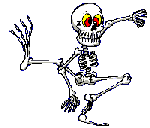
Structure and function
of the brain
* Cranial
Nerves
* Spinal
Nerves
Mechanisms of Brain Injury
* Ischemia
* Increased
Intracranial
Pressure (ICP)
Manifestattions of Brain
Injury
* Level of
Consciousness (LOC)
* Glasgow
Coma
Scale (GCS)
* Cranial
Nerve
Reflexes
Traumatic Brain Injury
* Types of
Brain
Injury
* Primary Injuries
* Epidural
* Subdural
* Subarachnoid
* Secondary
Injuries
* Treatment
Cerebral Vascular Accident
(CVA)
* Ischemic
Stroke
* Hemorrhagic
Stroke
* Treatment
* Long-term
Manifestations of
Stroke
CNS Infections
* Meningitis
* Encephalitis
Brain and Cerebellar Disorders
* Epilepsy
* Dementia
* Parkinson
Disease
Spinal Cord and Peripheral
Nerve Disorder
* Multiple
Sclerosis
* Spinal
Cord Injury
* Spinal Shock
* Neurogenic Shock
* Autonomic Dysreflexia
* Guillain
Barre'
Syndrome
Sensory Dysfunction
* Hearing
* Vision
* Taste
Pain
|
 Here's
a short PreQuiz to check your knowledge re: the A & P of the Neurologic
System. Just click the dot. Here's
a short PreQuiz to check your knowledge re: the A & P of the Neurologic
System. Just click the dot. 

Check Guyton and McCance
re: syllabus
for page numbers.
 Selected Selected
PowerPoint
Slides
Text
Version
 Memory Check 1:
Memory Check 1:
Consciousness-
A & P
 Memory Check 2:
Memory Check 2:
Divisions of the
Brain
 Memory Check 3:
Memory Check 3:
Blood Supply
 Memory Check 4:
Memory Check 4:
Terms-Levels of
Consciousness
 Memory Check 5:
Memory Check 5:
Seizures
 Memory Check 6:
Memory Check 6:
Meningitis &
Encephalitis
 Memory Check 7:
Memory Check 7:
ICP
 Memory Check 8:
Memory Check 8:
Brain Tumors
|

http://medstat.med.utah.edu/kw/brain_atlas
/index.htm
http://www.neuroguide.com
http://www.med.harvard.edu/AANLIB
/home.html
http://www.ninds.nih.gov/
http://www.
alzheimers.com
http://www.parkinson.org
http://www.efa.org
http://www.amhrt.org
http://www.neurosurgery.org/pubpages/
patres/anatofbrain.html
 Learning Activity 1:
Learning Activity 1:
Anatomical diagram
 Learning Activity 2:
Learning Activity 2:
Cranial Nerves
 Learning Activity 3:
Learning Activity 3:
Case Study: CVA
 Learning Activity 4:
Learning Activity 4:
Peripheral Nerve Disorder Chart
 Learning Activity 5:
Learning Activity 5:
Case Study: Seizures
|


